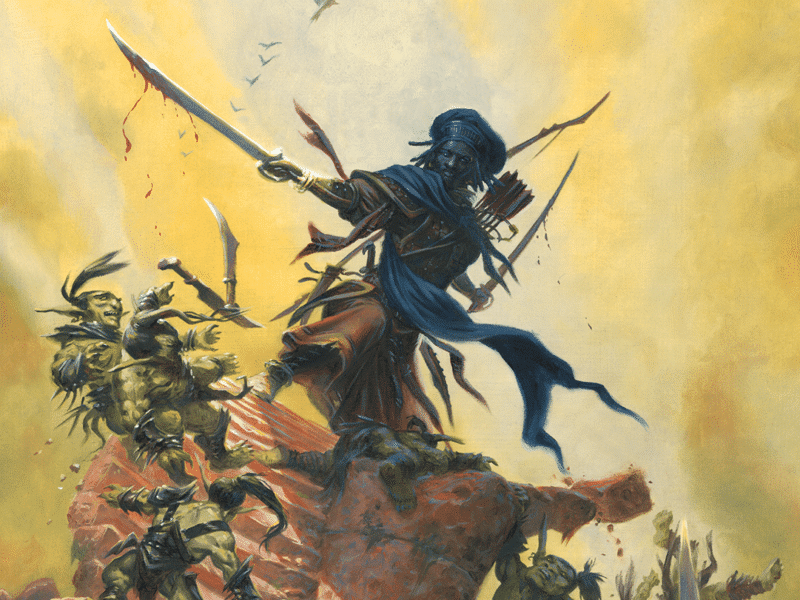While there’s been a rise of Dungeons & Dragons adventures and live-streamed gaming sessions that focus on intrigue, character development, mystery, politics and deceit, the game is at its heart a combat-oriented system. Even if many hours of playing time can pass without any fighting place, there are usually events when swords are drawn, visors lowered, and shields are raised. These moments are often among the tensest ones, not least because the characters’ lives are suddenly at stake, and a few unfortunate dice rolls can see the career of an aspiring adventurer (literally) cut short.
But as many long-time players have noticed, combat in the fifth edition of D&D can sometimes become predictable, drawn-out, and more a tedious obstacle than a real problem. In part, this is because this edition of the rules is rather non-crunchy and strongly favours simplicity over complexity, and its action economy is limited.
In addition, these days D&D is notoriously nice to the players’ characters. One example of this is found in that many spells and monsters have been de-fanged and are significantly less dangerous than in previous versions of the game. There are also the death saves, which increase the likelihood of a character’s continued existence, and there’s a variety of readily available spells that can prevent wounded adventurers from passing on – or even bring them back to life after they’ve perished. Lastly, the challenge ratings are not always indicative of how difficult a fight might be, and a balanced rating often means a walkover victory for the adventurers.
Consequently, unless the DM takes care, battles run the risk of becoming dull periods of dice-rolling that interrupt other parts of the adventure. If no one is really at risk, why worry about anything?
Fortunately, it’s easy for a crafty DM to make battles grab the players’ attention and really engage with the game. Some suggestions are actually made in the core rules: DMs need only to turn to page 271 in Dungeon Master’s Guide for a list of a few suggested additional combat actions that the characters – or their opponents – can use. But there’s much more that can be done, so keep reading for a few tips to ramp up the excitement next time your player group’s characters pick a fight!

That hurt!
Let’s start with an obvious but still controversial proposition: combat – in fact, the entire game – is more fun when it’s dangerous. And by that, I mean when the players know that their characters face a threat that might cause some serious damage to them – or even have the players roll new characters.
Some of this danger is inevitably mitigated by the rules, but it’s always possible to turn up the heat by adding more monsters, giving them more hit points, letting them do more damage – or all of the above. So if you feel that most fights are simple victories for the adventuring party, I advise you to gradually make the challenges harder by boosting the villains and the monsters. Chances are that you will be surprised by how tough opponents the characters can actually handle! This doesn’t automatically make for the best kind of surprises, but it’s simple and makes battles harder to win – which in turn makes them more memorable.
That really hurt!
For some additional mayhem, let critical hits have new effects in some battles or as a general rule. For example, if the characters are fighting a heavily armoured opponent, maybe a critical hit means that the attack slips through a crack in the armour and deals quadruple damage – but maybe the same opponent uses an unusually vicious sword that deals triple damage on a crit?
Or perhaps a perfect strike hits a lich’s magic medallion, which explodes and triggers a chain reaction that causes new enemies to storm into the lair. Only your imagination sets the limit to what might occur, but it’s good to write potential consequences down before the session as they can be a challenge to improvise.
What just happened?
Time to dive into other types of adjustments that generate much more excitement than just brawnier beasts! Tip number two: let something unexpected happen during the fight that makes the combat more challenging for the heroes. Surprises are the bane of all well-laid plans and typically prompt the players to rethink their characters’ strategies.
This can be something that the enemy does – they might suddenly grow in size and become twice as strong (often a reliably humorous turn of events!), or maybe they laugh sinisterly and reveal unforeseen powers that instantly turn them into a much more capable enemy! It could also be an alteration of the world around them, such as the arrival of more allies, a volcano erupting nearby, or the loss of gravity on the battlefield when fighting flying monsters.
As the DM, you don’t need to allocate certain actions to trigger these events unless they are typical combat-turn manoeuvres, such as drinking potions or drawing new weapons. Just let them happen before the battle is over, and ideally at the beginning of a new round or the start of the enemy’s turn.
Hands off our passenger!
High – and, even better, rising – stakes form the backbone of all good adventures. No surprise there: the stakes are what motives the characters to embark upon an adventure in the first place. Most groups will play by the unspoken rules, and accept a quest to clear a mine from intruding beasts or hunt down a fierce dragon in exchange for a sack of coin. But more engaging adventures feature stakes that concern people. For example, the heroes’ success or failure might determine the ultimate fate of a single prisoner – or a whole town.
Using people as part of the incentive for accepting a mission means that the stakes can be directly involved in the events, and thereby make combat even against low-level monsters more exciting and nerve-wracking. Let’s say that the adventurers have been tasked to protect a useless prince who must travel incognito between two towns for political reasons. In such a scenario, the characters might be level nine and armoured to their teeth, while the prince has the statistics of a commoner and can be taken out by a single arrow. This means that even a band of incompetent goblins that ambush travellers pose a threat to the prince, especially if the attackers are numerous.
Alternatively, the characters can have accepted a mission that means they must transport something incredibly fragile, or it could be a highly volatile object that might explode if it’s mishandled. Yet another option is to add a ticking clock to the mayhem: what if the battle takes place on a rapidly deteriorating stone bridge over a chasm, and the adventurers have only three rounds to conclude the fight before they must escape the collapsing stonework? Maybe they’re forced to flee, and the attackers have the opportunity to regroup and recover?
All of these situations are likely to make the players carefully consider what their characters do in a battle.
Do they hit us again?
You can also go ahead and change the fundamental mechanics of D&D battles by randomizing the initiative order, which is easily done by rolling for initiative as normal at the start of every new round. A word of caution: this often causes wildly unpredictable battles, but it can also make them feel much more realistic. Fair and just DMs make sure to inform their players about this way of running combat before the session starts so that no one is blindsided and must throw their character’s established strategies out the window.
How did they do that?
A super simple way to dial up the tension in a battle is to make the most of the monsters’ special reactions and legendary actions. However, as the core rulebooks reserve these almost exclusively for high-level monsters, there are rarely any surprises of this kind when battling weaker foes. Fortunately, a bit of preparation and creativity easily solves this problem, as you – being the Dungeon Master – have complete freedom to invent your own special reactions, bonus actions or standard actions for the monsters that you throw at the poor adventurers. Importantly, these actions don’t have to (and shouldn’t) be powerful, as their main purpose is not to boost the monsters’ power but to make fighting them more fun.
For example, let’s say that the adventurers are engaged in combat with a band of marauding gnolls that have dwelled in a dense forest for many years. Perhaps the gnoll have figured out ways to use the woodland to their advantage, and can use reactions to duck behind tree trunks or boulders and thereby increase their AC by a fraction.
Or maybe the gnolls live in a marshland filled with puddles of poisonous water, and can use reactions to splash this at the characters? Or what if the gnolls are simply highly capable warriors and can use condition-based actions to disengage their enemies, leap long distances, or use a special weapon? The possibilities are endless, and up to you to decide.
Environmental evils
A time-tested strategy for creating unpredictable battles and making them more dangerous is to let the very battlefield be a hazard. Maybe the field on which two armies clash is subject to a long earthquake that makes it difficult to move or even stand up, and might even trap characters if the dice rolls are terribly bad? The characters could be fighting a pair of giants on a steep mountainside in a thunderstorm with torrential rain, which might lead to adventurers slipping down several hundred feet – or getting struck by a lightning bolt from the sky. Or perhaps the common room in the tavern in which the characters are brawling is on fire, and all the exits are cut off? This could mean rolling a saving throw every turn to avoid burning themselves, or random dexterity saves to leap out of the way as flaming debris falls from the ceiling. Oh, and those bottles of dwarven spirits on the shelf over there might just work as improvised weapons that explode in balls of fire on impact!
It’s awfully dark in here
One of the most classic yet effective environmental complications is darkness. Natural gloom is rarely in D&D as the fifth edition rules have made darkvision more common than mead in a dwarven tavern. But a timely cast darkness still turns out the light for most characters who don’t have the ability to fight with accuracy even when they’re blinded. Likewise, there might be other factors that have the same effects such as darkness, such as dense fog or smoke. Even the most confident hero – well, at least some of them – will think twice before charging headlong into a room in which they can’t see farther than their own nose.
Other possibilities include spaces filled with intense heat, deathly coldness, toxic gases, or rivers of lava, all of which can have dire consequences for combatants. The key point here is that introducing some kind of obstruction or peril in the terrain is often more exciting than using a plain field.
What a ride!
As Dungeons & Dragons is a fantasy roleplaying game brimming with whimsy, there’s no reason to let the challenging terrain be limited to fire, mud or ice – especially not if the players’ characters are engaged in combat with epic monsters. In these instances, toss away the reins and go nuts with the environment! Maybe a teleportation device malfunctions, and suddenly the adventurers are fighting a mighty demon in freefall several thousands of feet above the ground. Or the combat could take place on a rapidly shrinking slab of rock afloat on a sea of lava in another dimension. If the characters are over level 14 or so, they should be able to cope with these kinds of dangers (but a wise DM makes sure that it’s possible).
These are but a few options available to DMs for turning predictable battles into tense nail-biting fests. What’s most important is that combat is fluid, entertaining, thrilling, and provides a sense of meaningfulness. So the next time that the players’ characters ready their weapons, make sure that they’re in for a treat!







